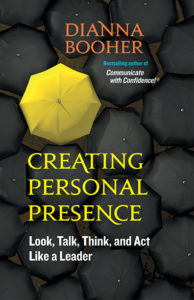


As you might imagine, during more than three decades of coaching presenters who frequently brief C-suite executives, I become engaged from two different perspectives:
Surprisingly, both parties almost always have pinpointed the same problems—but they differ on the causes and the solutions.
Executives want to hear your point—fast. Not your topic, but your point. Don’t promise that you’re going to cover topics X, Y, and Z in the next 20 minutes. Actually state your case in about 30-60 seconds. Debaters do it routinely. Then spend the rest of your time filling in the details.
Presenters, of course, wish executives had more patience. They’ve done the research and understand their subject or the problem to solve, but feel constricted to have to “say it all” in a few short sentences. It feels far easier to add background, caveats, and data before presenting conclusions—to stave off potential challenges from opinionated listeners.
At the opening is where any contention first arises—and where the presenter’s full confidence needs to be on full display.
Many high-potential briefers receive budget to fund research and work on a hot initiative. These smart people with great ideas polish their presentation to perfection. It’s their big chance for visibility across several functional areas of the organization. Their excitement feels palpable.
They plan 25 minutes of formal presentation to fill their 30-minute slot, leaving 5 minutes for questions. Then they’re surprised—and disappointed—at the polite applause at the end.
The problem? Executives expect a dialogue, not a monologue. In fact, some briefers get visibly ruffled when questions “interrupt” their flow. Big mistake. Plan to engage these strong personalities throughout your briefing.
The C-suite audience wants you to understand the technical details of your project or idea. They just don’t necessarily want to hear it all in detailed techno-color. In fact, they rarely want to hear the finer details unless they are equally as specialized as you are.
If they ask you a technical question, sure, you better be able to answer it accurately and convincingly. Try to fake it and chances are you’ll never make another presentation to them again.
But they expect you to have the skill to translate your technical expertise to a wider audience outside your specialized field. Yes, use your charts, graphs, KPIs, and flowcharts inside your department.
But when you get to the C-suite, upgrade the language a few notches so that others from outside your specialized field can understand what you’ve done, how it contributes to overall initiatives, and why it matters.
Although executives sometimes don’t define it as such, they routinely describe the symptoms:
On the other hand, many presenters have identified the symptoms themselves and wholeheartedly agree. They know the end goal: To think on their feet under pressure. To organize and express information and ideas clearly. To demonstrate poise and confidence.
Now that you know the chief complaints, solutions can take you to the C-suite successfully—as the presenter . . . and ultimately part of the executive team.
Lean more ways to polish your presentation skills in Creating Personal Presence: Look, Talk, Think, and Act Like a Leader.
